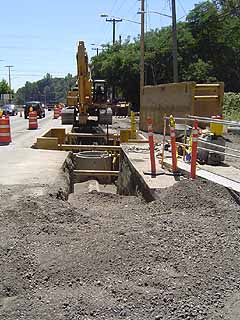|
Subscribe / Renew |
|
|
Contact Us |
|
| ► Subscribe to our Free Weekly Newsletter | |
| home | Welcome, sign in or click here to subscribe. | login |
Construction
| |
 |
September 16, 2004
Light-rail line hits fast forward
RCI Construction Group

Photo courtesy of RCI Construction Group
RCI-Herzog broke ground in July on Sound Transit’s $128 million Rainier Valley light-rail segment. The 4.3-mile project should wrap up in 2006.
|
Getting out ahead of the pack will allow the Rainier Valley Link light-rail project to get built more rapidly. Unique scheduling elements were designed to help Washington state's most complex transportation and utility project to be completed a year ahead of schedule.
The Rainier Valley Link light-rail project — part of Sound Transit's 14-mile Central Link between downtown Seattle and SeaTac — calls for a major reconstruction of the Rainier Valley corridor.
The 4.3-mile alignment will receive new water and sewer lines, power and communication lines, pavement, sidewalks, stations and plazas. Some areas will be widened to 175 feet to make way for the light-rail line, which will run down Martin Luther King Jr. Way South. Stations will be built at Edmonds, Othello and Henderson streets.
The track will be assembled in 78-foot lengths and pre-welded into 300-foot lengths using continuous welded rail strings. The strings will be transported to installation points throughout the corridor using specially designed rail carts that allow movement along paved areas.
A wetland mitigation site at Beer Sheva Park, on the west shore of Lake Washington, will be expanded and enhanced.
Unique sequencing
To keep the project on track, an advanced and unique type of sequencing plan and schedule is being employed.
The Rainier Valley alignment has been split into 10 sections, or "reaches," of approximately 2,300 feet in length.
The general contractor, RCI-Herzog, will install underground conduits to create 22 communication and power circuits, or "loops," providing new buried services to both sides of MLK Way. The new underground system will include street lights, traffic controls, signals and pedestrian crossings.
Seattle City Light will follow behind, installing new wire and energizing the system. Once the new system is energized and complete with new street lights the existing above-ground wire and poles will be removed.
After the deepest utilities are in place, work will return to the two starting points, where waterline and roadwork will begin, followed by track construction. Using two starting points to construct the 22 loops, the contractor and third-party utilities can complete more work in less time.
Scheduling solutions
The scheduling on this project functions as a time and task flow diagram as well as a normal critical path schedule.
The time and task schedule shows construction in a linear fashion and narrates how the different types of work will progress through the various reaches at any particular moment. This allows for a very clear overview of how construction will progress over the set project length.
By utilizing the time and task method, the scheduler can graphically show all phases of this project and any point in time.
Multiple crews
Deploying multiple crews in different reaches simultaneously allows several areas to be completed at once.
Three crews are currently installing the sanitary sewer and storm lines along the alignment, two of which are working on three reaches at a time in order to be ready for City Light and other utilities.
Once a communication and power loop has been completed, City Light will begin running two line crews from different starting points, followed by the contractor's water and roadwork crews, and then the track crews.
The crews play a game of "leapfrog" to get up and down the alignment, but working on multiple sections at once enables the project to be completed ahead of schedule.
All told, the project's coordination, sequencing and scheduling methods should trim 12 months off the construction time, reducing it from three years to two.
Traffic safety
Traffic control is vital to the safety of the community and employees on this project.
The magnitude of the project demands a total commitment from the project team and third parties. With the possibility of as many as 15 crews working along the alignment at one time, the contractor, the city of Seattle and the 18 third-party agencies will work together to keep traffic delays to a minimum.
As crews proceed through the reaches, temporary traffic signals, street lights and pedestrian crossings will be placed throughout the project until permanent traffic controls are established.
Lauren Robison is involved in project management, community outreach and the special projects division at the RCI Construction Group.
Other Stories:
- A cheaper way to treat runoff
- Skagit Station offers hope for renewal
- Staving off the pitchforks and torches
- Creating a seamless regional transit system


